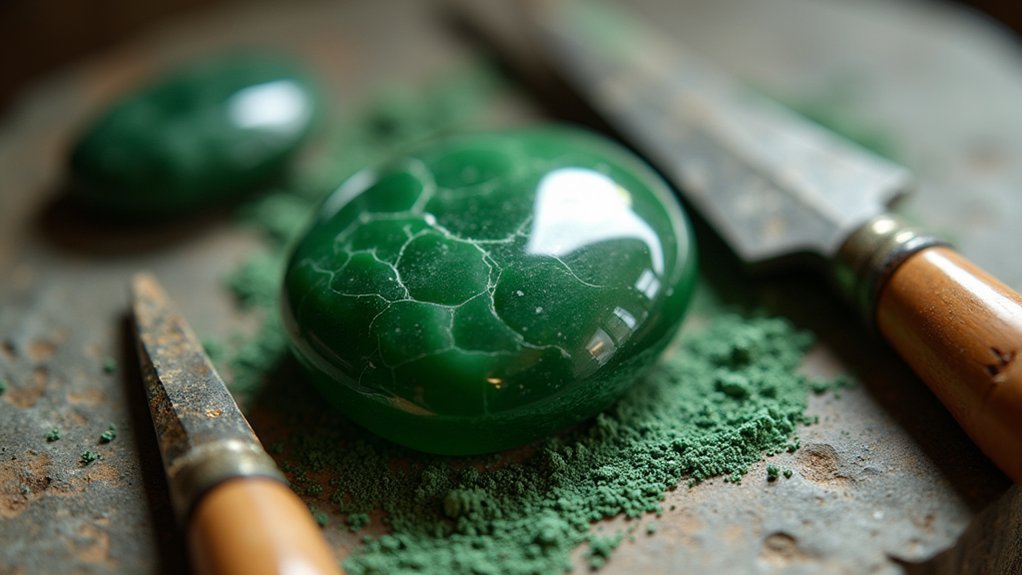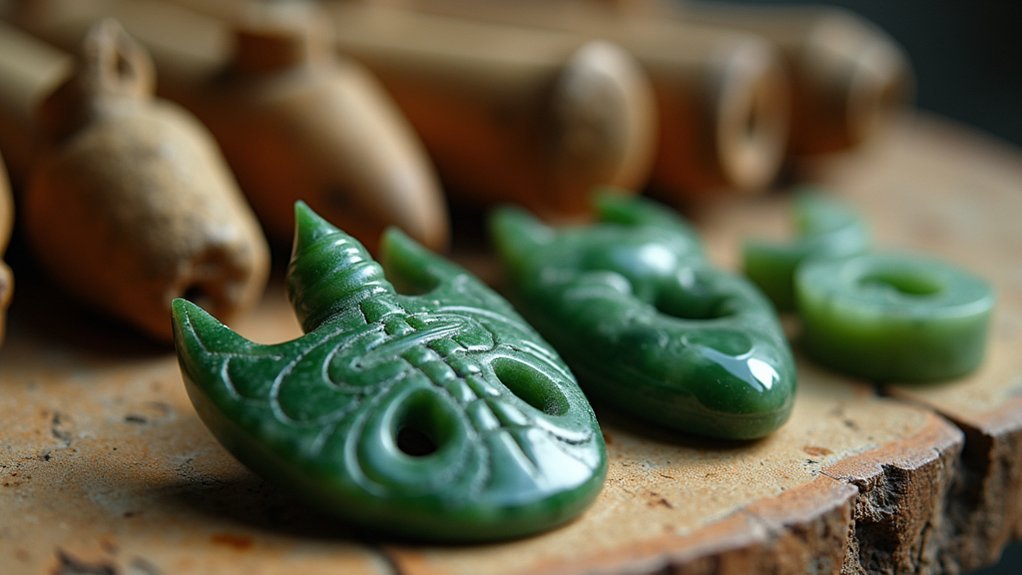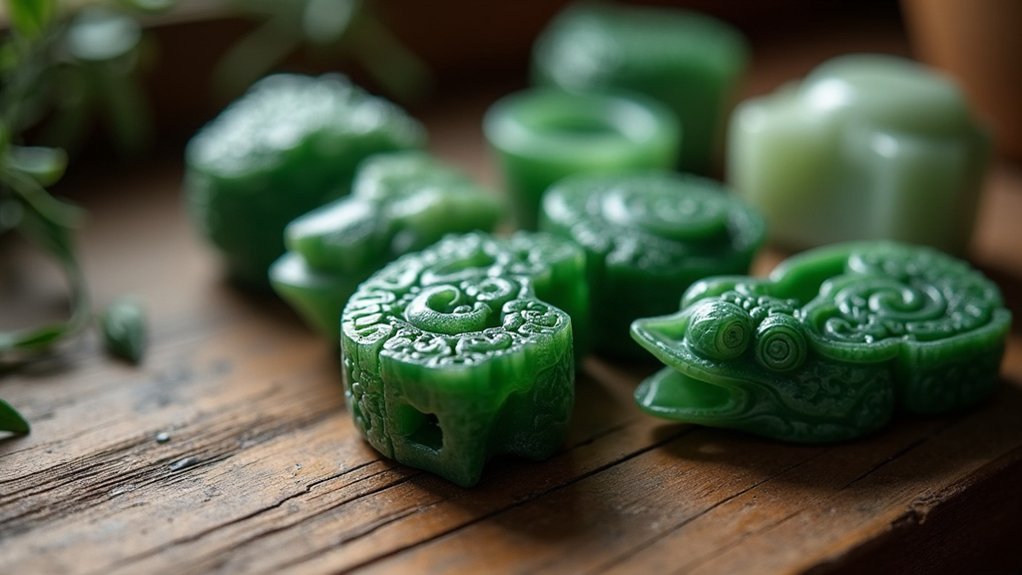Mesoamerican jade carving secrets include testing stones by sound for quality, using powdered garnet as the primary abrasive, employing string sawing for precise cuts, utilizing bow drilling with wooden tools, cooling with water during polishing, carving symbolic elements that connect humans to deities, and organizing workshops through strict apprenticeship systems. You’ll discover how these ancient artisans created pieces with exceptional luster while embedding profound spiritual meanings that connected royal elites to cosmic powers.
The Sacred Selection of Jade: Identifying Quality Stones Through Ancient Methods

When ancient Mesoamerican artisans sought the perfect jade for their ceremonial carvings, they relied on sophisticated evaluation methods that modern gemologists would recognize.
You’d find these craftspeople examining stones for translucency and color variations, preferring jadeite over nephrite for its superior aesthetic properties.
The quality assessment began with visual inspection of the boulder’s bark-like rind.
You can imagine artisans striking the stones to hear the distinctive ring that indicated density and quality—a perfect jade produces a musical tone unlike other green stones.
They’d also employ the methylene iodide test to determine specific gravity through buoyancy.
When pounding rocks with sledgehammers, these ancient specialists weren’t just creating workable pieces; they were revealing the internal structure that would guide their selection of the finest stones for sacred objects.
Abrasive Techniques: Powdered Garnet and String Sawing Mastery
Unlike their contemporaries around the world, Mesoamerican artisans conquered jade’s remarkable hardness through ingenious abrasive techniques that didn’t rely on metal tools. Instead, they mastered the use of powdered garnet as a primary abrasive, allowing for exceptional polish on jade objects that still gleam today.
| Technique | Tools Used | Purpose |
|---|---|---|
| String Sawing | Cord with abrasives | Precise cutting |
| Bow Drilling | Wooden drill with abrasives | Creating holes |
| Surface Polishing | Garnet powder | Final finishing |
You can see the profound craftsmanship in how artisans combined these methods with wooden implements to create intricate designs. These abrasive techniques weren’t merely functional—they were essential to Mesoamerican cultures, enabling the creation of jade carvings that carried deep religious significance while showcasing extraordinary artistic skill.
Drilling Mysteries: Hollow Reed and Bow Drill Applications

You’ll be amazed how Mesoamerican artisans achieved pinpoint drilling in jade without metal tools, using hollow reeds as guides for their bow drills.
They’d combine these reed tubes with a wooden bow that rotated a stone or hardwood drill bit, allowing for precise holes in even the toughest jade pieces.
The effectiveness of this technique improved further when they added abrasive slurries of crushed garnet or jade powder, creating friction that cut through the stone while simultaneously polishing the surface.
Precision Without Metal Tools
Despite having no access to metal tools, Mesoamerican jade carvers achieved remarkable precision in their craft through ingenious drilling techniques.
Ancient artisans from these Mesoamerican civilizations mastered the bow drill, combining it with hollow reed “pipes” to create intricate holes and designs in their jade artifacts.
You’ll be amazed by how they enhanced their drilling techniques:
- Using crushed garnet or jade dust as abrasives to increase cutting efficiency
- Applying hollow reeds as drill pipes for creating precise, clean holes
- Employing bow drills with stone bits to achieve controlled rotation and detailed work
This sophisticated craftsmanship was passed through generations, preserving jade carving expertise that produced elaborately designed pieces.
Their extraordinary precision demonstrates how innovation overcame technological limitations, resulting in masterpieces we still admire today.
Abrasive Slurry Techniques
The remarkable precision of Mesoamerican jade work relied heavily on their mastery of abrasive slurry techniques. By combining crushed garnet or jade dust with water, artisans created an effective cutting medium that amplified their drilling techniques.
You’ll find their ingenuity most evident in their use of hollow reeds as tubular drills. These simple tools, when paired with the abrasive slurry, allowed Mesoamerican jade carvers to achieve intricate designs that would be impossible with solid drills alone.
The bow drill provided the consistent rotational force needed to drive the reed into the stubborn jade.
This advanced craftsmanship demonstrates how these ancient artisans overcame jade’s natural hardness. Without metal tools, they leveraged the mechanical advantage of their drilling apparatus and the cutting power of abrasive particles to transform raw jade into elaborate cultural treasures.
Water and Patience: The Mesoamerican Polishing Process
While modern lapidaries employ electric tools to shape and polish jade, ancient Mesoamerican artisans achieved equally stunning results through a painstaking process that relied on two essential elements: water and remarkable patience.
Water served as the vital cooling agent during polishing, preventing heat damage while reducing friction between jade and abrasives.
You’ll find that craftsmanship of this caliber demanded extraordinary dedication, with artisans often spending:
- Days perfecting a single piece’s surface
- Hours methodically applying powdered jade or garnet as natural abrasives
- Multiple sessions using specialized wooden tools like lignum vitae blades for precise shaping
This methodical approach resulted in ceremonial items and jewelry with exceptional luster and exquisite detail—testaments to the artisans’ patience and mastery of this challenging material.
Symbolic Carving Patterns: Embedding Cultural Meaning in Jade

You’ll notice Mesoamerican jade carvings frequently blend human and animal features to create potent deity hybrids, with feline and bird elements appearing consistently across Olmec, Maya, and Aztec works.
These composite beings weren’t merely decorative but embodied complex theological concepts, connecting the wearer or owner to specific cosmic powers and natural forces.
The craftsmen also incorporated smaller symbolic elements representing life essence—such as scrolls, dots, and flowing patterns—that transformed each jade piece into a microcosm of Mesoamerican spiritual understanding.
Deity Hybrid Motifs
Ancient Mesoamerican civilizations masterfully encoded their spiritual beliefs into jade through complex deity hybrid motifs, creating physical manifestations of divine power.
These Olmec jade sculptures combined human and animal traits, embodying the symbolic authority of deities that ruled their cosmology.
When you examine these intricate carvings, you’ll notice three defining characteristics:
- Feline elements like jaguar features representing strength and earthly power
- Avian components such as bird beaks symbolizing connections to celestial domains
- Human attributes merged with animal traits to convey the hybrid nature of divine beings
Maya artisans furthered this tradition by incorporating glyphs that reinforced the elite’s connection to spiritual authority.
Through these hybrid motifs, jade transformed from mere stone into powerful conduits between the natural world and divine forces.
Microcosmic Life Symbols
The intricate symbols carved into Mesoamerican jade pieces reveal a profound understanding of life’s cyclical nature, embedding cultural meaning into every incision and polished surface.
When you examine these symbolic patterns, you’ll notice how artisans captured concepts of life and fertility within miniature carved worlds.
Maya craftsmen frequently incorporated maize motifs in their jade carvings—not merely as decoration, but as powerful representations of sustenance and regeneration for both the living and deceased.
Similarly, Aztec jade objects featured flowing water designs associated with Chalchiuhtlicue, conveying abundance and liveliness.
These weren’t simply aesthetic choices. Each pattern in Mesoamerican jade carving served as a vehicle for spiritual beliefs, transforming the stone into something far more significant—a tangible connection between the physical world and cosmic forces.
Royal Workshop Traditions: Organization and Apprenticeship Systems
While ordinary craftsmen worked with various materials throughout Mesoamerica, jade carving remained a specialized art form organized under royal patronage.
These workshops reflected strict social hierarchies, with elite artisans enjoying higher status and access to premium materials. Master artisans selected young apprentices, teaching them the meticulous techniques that transformed raw jade into treasured artifacts.
The apprenticeship system followed three key phases:
- Basic training in tool usage, including wooden saws and bow drills
- Practice with polishing techniques and abrasives on lesser materials
- Advanced instruction in artistic innovation and regional stylistic elements
You can observe the legacy of these workshop traditions in archaeological finds today, where the extraordinary craftsmanship reveals both the technical precision and creative expression that flourished under royal sponsorship.
Ceremonial Tools and Rituals: The Spiritual Dimension of Jade Carving

Beyond its aesthetic value, jade permeated every aspect of Mesoamerican spiritual life, functioning as both medium and messenger between human and divine spheres.
You’ll find jade ceremonial tools were crafted with exceptional precision, reflecting their vital role in rituals connecting mortals with deities.
Olmec peoples utilized jade perforators during bloodletting ceremonies, believing these rituals guaranteed community fertility and opened channels to ancestral dimensions.
Maya kings were interred with elaborate jade masks and pectorals that served as passports to the afterlife while symbolizing their divine authority.
The Aztecs further elevated jade’s spiritual significance by associating it with Chalchiuhtlicue, often repurposing ancient jade artifacts in their own rituals.
This practice connected them to a divine heritage spanning centuries, demonstrating how jade embodied Mesoamerican spiritual beliefs about life, fertility, and the eternal water cycle.
Frequently Asked Questions
How Did the Mayans Carve Jade?
You’ll find Mayans carved jade using wooden lignum vitae blades and bow drills. They’re applying garnet abrasive sand and crushed jade as tools, which they’ve combined with adhesives to achieve their intricate designs and polished finishes.
How Did the Ancients Carve Jade?
You’d be amazed how ancients carved jade with wooden tools! They’d use lignum vitae blades, bow drills, and string saws with crushed garnet abrasives. They’d identify quality jade by its distinct ring when struck.
What Is the Significance of Jade in Mesoamerica?
In Mesoamerica, you’ll find jade symbolized life, fertility, and divine power. It’s not just beautiful—it’s sacred. You’d see it adorning royalty, placed with the dead, and connecting people to their gods.
Are Jade Carvings Worth Anything?
Yes, your jade carvings can be extremely valuable. They’re worth thousands to millions depending on authenticity, age, craftsmanship, and provenance. Ancient Mesoamerican pieces command the highest prices in today’s collector’s market.
In Summary
You’ve now glimpsed the secretive world of Mesoamerican jade carving, where spiritual practice and technical mastery intertwined. These seven ancient traditions reveal how artisans transformed raw stone into sacred treasures through specialized techniques passed down for generations. When you next admire these artifacts in museums, you’ll recognize the painstaking dedication and cultural wisdom embedded in each piece—a hallmark of innovation that modern technology still can’t fully replicate.





Leave a Reply